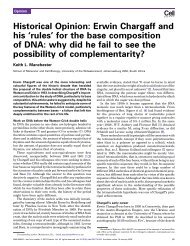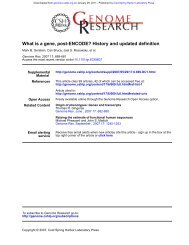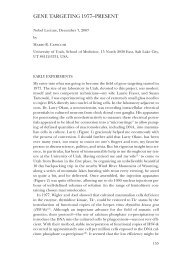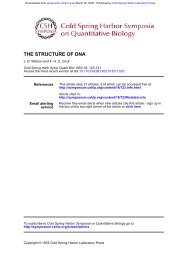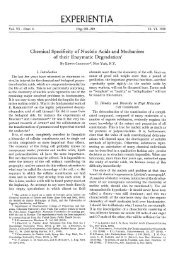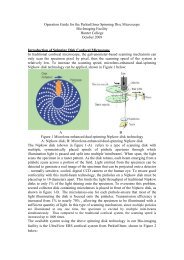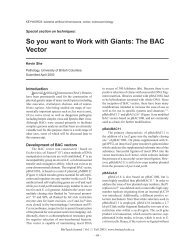Chargaffs Legacy.pdf - Biology
Chargaffs Legacy.pdf - Biology
Chargaffs Legacy.pdf - Biology
- No tags were found...
Create successful ePaper yourself
Turn your PDF publications into a flip-book with our unique Google optimized e-Paper software.
D.R. Forsdyke, J.R. Mortimer / Gene 261 (2000) 127±137 131with complementary pyrimidine clusters, and since pyrimidineclusters are scarce in mRNAs, purine clusters shouldoccupy the unpaired regions of mRNA secondary structures,primarily the loops. Indeed, this is where they are found incalculated structures (Bell and Forsdyke, 1999b). Whyshould it be advantageous for an mRNA to `load' its loopswith purines?A possible answer to this question derived from thestudies of Jun-ichi Tomizawa and his colleagues on theway `sense' and `antisense' RNA molecules interact, priorto forming a double-strand duplex molecule (dsRNA;Eguchi et al., 1991; Bull et al., 1998). It was found thatsense sequences in RNA search out complementary antisensesequences through `kissing' interactions between thetips of the loops of stem-loop structures. If Watson-Crickbase-pairing between the loops is achieved, the interactionmay then proceed to the formation of dsRNA. Thus, ifRNAs were generally purine-loaded, `kissing' interactionswould decrease, and hence the probability of formingdsRNA would decrease. How could failure to formdsRNA be of selective advantage? This will be consideredin two steps. First, we consider how the tendency to purineloadmight have ®rst arisen to prevent self-RNA±self-RNAinteractions. Second, we consider how cells might havefurther exploited this tendency, in order to recognize nonself-RNAs.The `distraction hypothesis' (Bell and Forsdyke, 1999b)points out that the physico-chemical state of the `crowded'cytosol (Fulton, 1982; Forsdyke, 1995d) is likely to behighly conducive to a most fundamental interaction, thatbetween the codons of mRNAs and anticodons at the tipsof loops in tRNAs. This results in transient formation ofdsRNA segments, which normally would not exceed ®vebase pairs (Bossi and Roth, 1980). However, a cytosolicenvironment which favours mRNA-tRNA kissing interactionswould also favour mRNA-mRNA kissing interactions.This `distraction' could have impeded mRNA translationand hence could have decreased the rate of protein synthesis.If, when not seriously con¯icting with their codingrole, mRNAs had accepted purine mutations in loop regions,then this `purine-loading' would have diminished mRNAmRNAinteractions and increased the ef®ciency of proteinsynthesis. In some cases, so important has been the need toaccept purine mutations, even the coding role appears tohave been compromised (Rocha et al., 1999; Lao andForsdyke, 2000). When this compromise is not possible,then the length of the protein can be increased by insertingsimple sequence repeats of amino acids with purine-richcodons between functional domains (Cristillo et al., 1998;Forsdyke, 2001).The presence of mechanisms to avoid inadvertant formationof extensive segments of dsRNAs as a result of interactionsbetween self-RNAs, leaves open the possibility ofthe evolution of mechanisms utilizing dsRNA as an intracellularalarm against not-self-RNAs. This was ®rst recognizedin the interferon response by which a cell infected by avirus communicates that fact to other cells of an organism. Itwas found that dsRNA was a most powerful inducer ofinterferon and of other antiviral adaptations (Isaacs, 1962;Ehrenfeld and Hunt, 1971; Marcus, 1983). However, PhillipSharp (1999) noted that `it remains a mystery how cellstreated with interferon speci®cally suppress the translationof viral mRNAs in their cytoplasm and not cellularmRNAs'. Thus, as with so many problems in biology, theself/not-self discrimination aspect appears central.Recently, dsRNA has been found to mediate intracellularalarms in a variety of plants and animals infected with intracellularpathogens; these pathogens, in turn, have evolvedmechanisms to inactivate components of the alarm system(Voinnet et al., 1999; Fire, 1999).Although the mechanism of dsRNA formation is stilluncertain (Hamilton and Baulcombe, 1999), one explanationfor how an exogenous agent is recognised as not-selfand triggers the formation of dsRNA challenges our usualway of regarding the mRNA population of a cell. This populationseems obviously heterogeneous because it consists ofmultiple mRNA species each encoding a different product, ±a powerful viewpoint which preempts the search for alternativeexplanations. However, if we consider the possibilitythat heterogeneity can serve more than one purpose, then wecan regard the heterogenous intracellular mRNA populationin the same way as we regard the heterogenous extracellularimmunoglobulin population. The latter constitutesthe ®rst barrier against foreign pathogens (`not-self'), whichselect from among the immunoglobulins (which have beenrandomly generated and then pre-selected for non-reactionwith self antigens) those with speci®city for the coat antigensof the pathogen.In the case of a virus, the coat is relinquished at the timeof entry into a cell, and the cell's ®rst possible line of intracellulardefence would be to recognize the foreign nucleicacid as `not-self', either in its genomic form, or in the formof an early transcript. This implicates dsRNA. Perhaps asegment of a particular host mRNA species, because ithappened to have suf®cient sequence complementarity,would form a double-stranded segment with viral RNA ofsuf®cient length (at least two helical turns) to trigger analarm response (Izant and Weintraub, 1984; Melton, 1985;Robertson and Mathews, 1996; Tian et al., 2000). Thus, theheterogenous mRNA population can be seen as consistingof `RNA antibodies', which have been preselected overevolutionary time not to react with `self' RNAs, whileretaining, and if possible developing, the potential to reactwith `not-self' RNAs. Since, due to failure of transcriptiontermination, a low level of transcription of extra-genic DNAis possible (Heximer et al., 1998), the maximum potentialrepertoire of `RNA antibodies' is limited only by genomesize. A second line of intracellular defence would be recognitionof the translation products of virus genes; a mechanismfor this form of self/not-self discrimination is discussedelsewhere (Forsdyke, 1995d).



